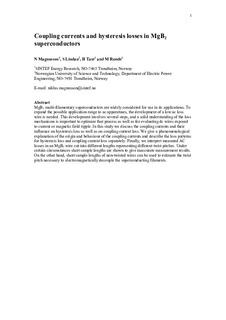Coupling currents and hysteresis losses in MgB2superconductors
Journal article, Peer reviewed
Accepted version
Permanent lenke
http://hdl.handle.net/11250/2470495Utgivelsesdato
2014Metadata
Vis full innførselSamlinger
- Institutt for elkraftteknikk [2468]
- Publikasjoner fra CRIStin - NTNU [38127]
Originalversjon
10.1088/0953-2048/27/10/105003Sammendrag
MgB2 multi-filamentary superconductors are widely considered for use in dc applications. To expand the possible application range to ac apparatuses, the development of a low ac loss wire is needed. This development involves several steps, and a solid understanding of the loss mechanisms is important to optimize that process as well as for evaluating dc wires exposed to current or magnetic field ripple. In this study we discuss the coupling currents and their influence on hysteresis loss as well as on coupling current loss. We give a phenomenological explanation of the origin and behaviour of the coupling currents and describe the loss patterns for hysteresis loss and coupling current loss separately. Finally, we interpret measured ac losses in an MgB2 wire cut into different lengths representing different equivalent twist pitches. Under certain circumstances short sample lengths are shown to give inaccurate measurement results. On the other hand, short sample lengths of non-twisted wires can be used to estimate the twist pitch necessary to electromagnetically decouple the superconducting filaments. For the studied MgB2 wire, with a pure titanium matrix, the losses were mainly hysteretic, although the level of these losses was lowered when reducing the equivalent twist pitch, and thereby the coupling currents. At 35 K the reduction in loss started at an equivalent twist pitch of approximately 36 mm, where the filaments were assumed practically fully coupled. The decoupling then continued all down to the shortest equivalent twist pitch of 9 mm.
